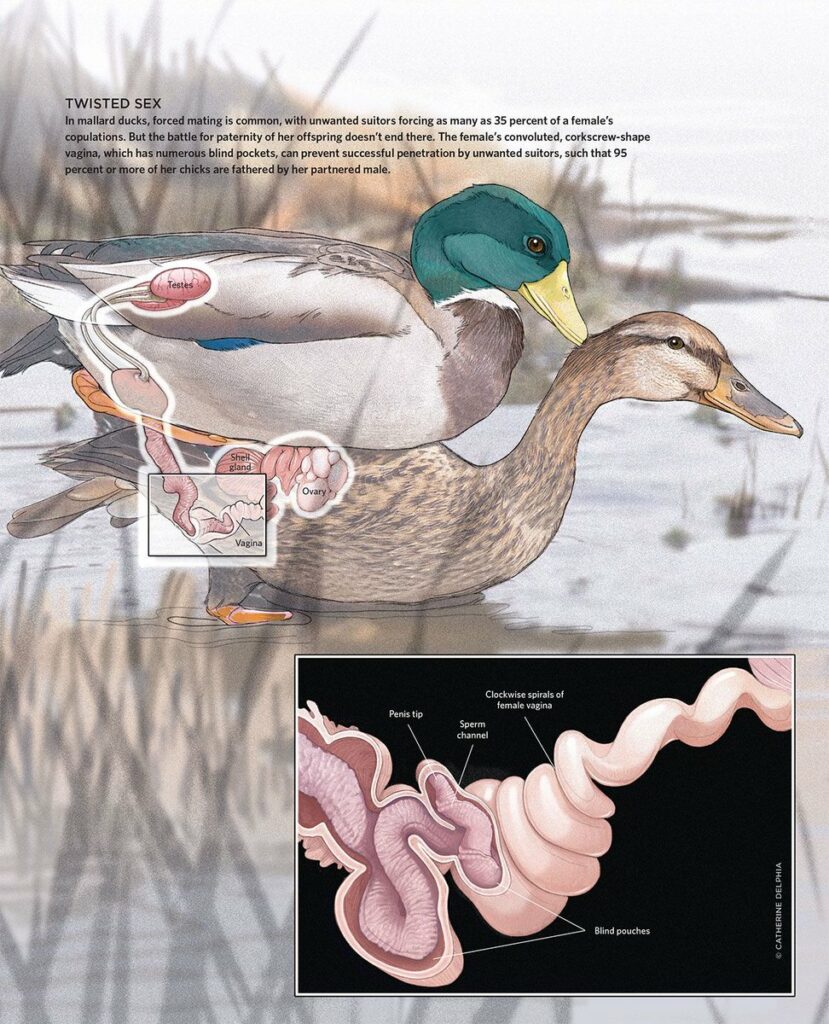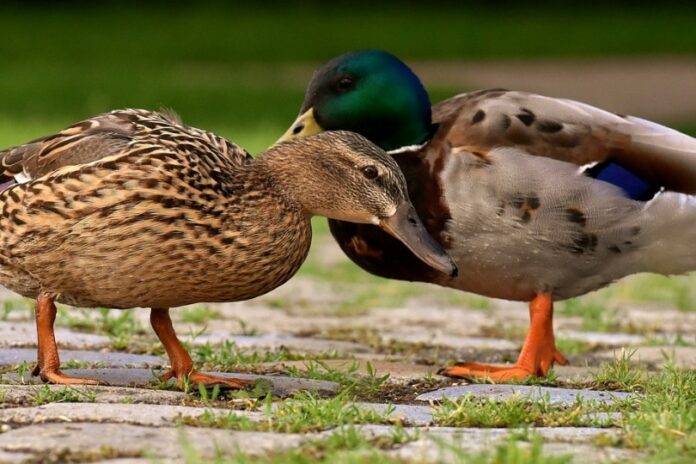Do Ducks Mate For Life? Thinking of ducks as staying together forever like people is entertaining. Yet, in nature, ducks don’t mate for life. Their mating habits are intriguing, as they use unique methods such as special dances or calls or displaying their vibrant feathers to catch a mate’s eye. While they may stay with their chosen partner for the breeding season, they might choose someone new next year. It’s captivating to understand how animals choose their mates.
“Forever Together” – A saying that holds for geese but not usually for ducks. Ducks don’t always stay with the same partner for their whole life. They pick a partner for the breeding season and then pick a new one next year. The mom duck takes care of the babies independently, and the dad duck doesn’t help.
Ducks exhibit a unique mating behavior compared to other birds, as they are “seasonal monogamists” and change partners annually. Despite the annual change, they still exhibit strong bonding during the breeding and raising of their ducklings.
The female ducks typically take on most childcare responsibilities, while the males play a limited role.
Unlike geese and swans that maintain lifelong pair bonds, most ducks practice “seasonal monogamy,” where they choose a mate for each breeding season, potentially changing partners the next year. Reuniting with a previous mate is rare.
Ducks exhibit diverse mating and breeding practices, from maintaining a year-long partnership to seasonal mating. Some display affection through special behaviors such as dancing or gift-giving.
However, in the event of a mate’s death, the survivor must find a new partner for the next breeding season. The female ducks also face danger during egg-laying due to the threat of predators.
ALSO READ: What Do Ducks Eat? (Complete Guide)
Let’s dive deeper to know if ducks mate for life or do they change partners.
Do Ducks Mate For Life?

Ducks are “seasonal monogamists,” meaning they mate for the breeding season but switch partners the following year for optimal reproduction.
They are social creatures with intricate communication methods, using distinct sounds for mate attraction, danger signals, and communicating with their offspring.
Despite not having life-long pair bonds, ducks still exhibit strong connections during breeding.
Most ducks engage in “seasonal monogamy,” where they mate with a different partner each breeding season.
Only a few duck species form longer-term bonds and mate with the same partner for multiple years, usually when they return to their traditional mating ground year after year.
Ducks generally don’t maintain lifelong pair bonds and instead mate with different partners each breeding season.
However, certain species, such as harlequin ducks, goldeneyes, eiders, buffleheads, and long-tailed ducks, have a chance of recognizing and reuniting with a previous mate if they visit the same habitats annually, which is not a frequent occurrence.
Ducks are fascinating creatures with varying mating behaviors. While some, like swans and geese, mate for life, others, such as mallards and Muscovies, switch partners annually for breeding. This is common, so don’t be taken aback if you observe a duck with a different mate the next year.
Ducks typically exhibit “seasonal monogamy,” meaning they mate with a new partner each breeding season, unlike geese and swans, who mate for life. Usually, female ducks take on the responsibility of caring for the ducklings with little to no assistance from males. However, some duck species can reunite with previous mates if they encounter each other again the following year.
Ducks typically have a yearly mating pattern, where they find a partner for one breeding season but then move on to a new mate the following year.
Unlike geese and swans, who have lifelong mating partnerships, male ducks typically don’t assist in raising the offspring and move on after the eggs hatch.
ALSO READ: Do Ducks Have Teeth? Everything You Need to Know About Duck Teeth
How Do Ducks Attract Their Mates?
Ducks mate differently from birds such as geese and swans, who have lifelong pair bonds. Instead, ducks engage in “seasonal monogamy,” finding a new mate each breeding season.
During the breeding season, from December to March, they form close bonds, but once the eggs hatch, the males typically depart and do not assist with parenting.
After bonding, a male and female duck will build a nest and attend to the eggs together until they hatch.
The mother then raises the ducklings, while the father may or may not stick around to provide protection. However, typically the father will depart and find a new mate for the next breeding season.
Ducks change partners every year. Unlike some other birds, they don’t stick with one mate for their whole life. When the female duck is ready to have baby ducks, the male ducks show off their feathers and make sounds of winning her over. The female then chooses which male duck she likes the most. But once the baby ducks are born, the dad duck usually leaves and doesn’t help care for them.
The typical steps followed during duck courtship and, ultimately, mating are as follows:
- Head bobbing: When ducks want to start a family, they have special ways of showing it. One way is by doing something called head bobbing. The boy duck and girl duck will swim close together and move their heads up and down simultaneously. This means they like each other and wants to be together.
- Flat-backing: When a female duck is ready to mate, she will flatten her back and stretch out her neck on the water’s surface. She will also swim toward the male duck she has chosen. This is a sign that she is ready to mate with him.
- Copulation: The male duck jumps on top of the female duck’s back and holds onto her neck feathers with his beak. This helps him balance during mating. Sometimes the female duck might not want to mate, and it can look like a lot of quacking, flapping, and moving around.
- Whistle-grunt: The final step in duck courtship is the whistle grunt. The male duck makes a loud noise like a whistle and sometimes a short, loud grunt. This is the last step in the courtship ritual before the ducks mate.
- Victory lap: After the male duck and female duck have chosen each other, the male will swim close to the female and bob his head up and down. This is a sign that they are both interested in each other. Next, the female will lie flat on the water and stretch her neck. This is a sign that she is ready to mate. The male will climb on top of the female and hold onto her feathers with his beak. This is called “copulation.” After this, the male might make a loud whistle and grunt noise and swim around the female in a circle. This is called a “victory lap.”
Check the video below to know how ducks mate.
ALSO READ: 14 Simple Tricks to Keep Ducks Away From Your Pool
What If a Duck Mate Dies?
If a female duck’s partner dies early in the breeding season, she will quickly find another mate and continue breeding and raising babies.
For most ducks, if the mommy duck’s partner dies, she will find another partner really fast so she can keep having babies. This is because there are many daddy ducks and not as many mommy ducks, so there’s always a daddy duck ready to step in and help.
SHOCKING FACT: Ducks may look cute but they are sadistic raping monsters. (Source)
Do Ducks Mourn the Loss of a Mate?
Most ducks don’t stay with the same partner forever, and they choose someone new every year. But if a duck’s partner dies, they might look for another one. Some people think that ducks might feel sad when their partner is gone, but this has only been noticed when people are watching ducks really closely.
Some ducks change partners every year and don’t stay with the same mate forever. If a male duck dies, the female might find a new partner.
People aren’t sure if ducks feel sad when their partner is gone, but some think that if the duck saw their mate die, they might be upset. Others think ducks might just be confused when their partner is not there anymore.

Do Female Ducks Mate With Each Other?
Ducks are birds that can be found in many different parts of the world. Some ducks mate for life, which means they stay with the same partner forever, but most ducks are different.
They are called “seasonal monogamists,” which means they pair up before the breeding season but then choose a different mate the next year.
The females usually take care of the ducklings alone, and the males do not help. There are some exceptions, like some ducks that visit the same place every year and find each other again. But this is not common for all duck species.
Some ducks in the wild form pairs with other ducks of the same gender, like female-female or male-male pairs. This has been seen in certain types of shelducks, grebes, wood ducks, scaup, and more.
ALSO READ: Why Do Ducks Stand on One Leg? You Will Be Amazed to Know
Do Ducks Mate For Life – Summary
- Ducks commonly exhibit “seasonal monogamy” by pairing with different partners each breeding season.
- Only a handful of species can reunite with past mates if they frequent the same habitat each year.
- Male ducks don’t typically participate in offspring care and depart after the eggs hatch.
- Male ducks show off using head bobbing and other displays to attract female mates during the breeding season.
- The female selects the male she prefers and builds a nest together until the eggs hatch.
- Upon hatching, the male typically leaves, and the female raises the ducklings solo.
ALSO READ:
Can Ducks Fly – A Complete Guide on Ducks Flight




